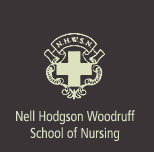














|
 |
| |
From the Alumni President
The case for nursing informatics
Preventing patient falls
A Thermometer's Tale |
|
| |
|
|
| |
News:
|
1940s
1960s
1970s
1980s
1990s
2000s
Faculty/Staff
News
|
Deaths:
|
1930s
1940s
1950s
1970s
1990s
Other Deaths
|
|
| |
|
|
|
| |
|
CLASS
NOTES |
|
| |
|
|
|
| |
|
1940s
|
|
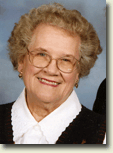 |
Harriet
Smith Head, 45N, of Fairburn, GA, worked in several states
and is now retired. Her last nursing position was at Piedmont Hospital
in Atlanta as an office nurse with an ob/gyn practice. “I
still have great memories of the nursing school during World War
II,” she writes. |
|
| |
|
|
| |
|
1960s
|
|
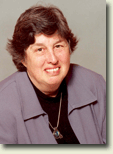 |
Dr. Karen Buhler-Wilkerson, 63Ox, 66N, 69MN, received a
2005 Lindback Foundation Award for Distinguished Teaching at Pennsylvania
State University, where she is a professor of community health in
the School of Nursing. Buhler-Wilkerson recently curated an exhibit
there, “RN: The Past, Present, and Future of Nurses’
Uniforms” and also teaches nursing history. The award presentation
cited her tremendous impact on the nursing school during her more
than 30 years there. A former student writes, “My goal as
a new assistant professor is to bring to my own students the level
of commitment to and passion for teaching that Dr. Buhler-Wilkerson
gave to me.” |
|
| |
|
|
|
| |
|
| |
 |
|
 |
From
the Alumni President
 ur
ranks are growing again. This May, the Nell Hodgson Woodruff
School of Nursing graduated 95 nurses with undergraduate and
advanced degrees. In August, 51 ur
ranks are growing again. This May, the Nell Hodgson Woodruff
School of Nursing graduated 95 nurses with undergraduate and
advanced degrees. In August, 51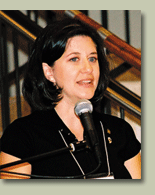 master’s students completed their degrees and were welcomed
as our newest alumni. This September, 109 BSN students, 83
MSN students, and four new PhD students join our programs
from across the United States and around the world. This cycle
is more than the predictable ebb and flow of students becoming
alumni. In the hearts and minds of each of these current students
and future colleagues lies the future of the profession of
nursing. The challenges of nursing in the 21st century are
changing daily, and Emory’s School of Nursing is well
positioned to be a driving force in meeting those challenges
during the next century.
master’s students completed their degrees and were welcomed
as our newest alumni. This September, 109 BSN students, 83
MSN students, and four new PhD students join our programs
from across the United States and around the world. This cycle
is more than the predictable ebb and flow of students becoming
alumni. In the hearts and minds of each of these current students
and future colleagues lies the future of the profession of
nursing. The challenges of nursing in the 21st century are
changing daily, and Emory’s School of Nursing is well
positioned to be a driving force in meeting those challenges
during the next century.
Over the past year, we have
celebrated a century of excellence in caring and nursing education.
We have recognized the strong foundation from which our school
has grown and celebrated those individuals who helped put
us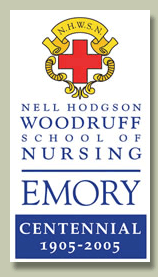 where we are today. We are proud of how much our alumni have
accomplished in the field of nursing (including those featured
in this magazine). Today, approximately 10,000 Emory-prepared
nurses are leading the way in patient care, public health,
research, health education, and health policy around the world.
Our accomplishments have always been, and will continue to
be, measured against the time-honored traditions of scholarship,
leadership, and social responsibility. As we strive to address
the critical shortage of nurses worldwide, we can rely on
these tenets as touchstones to anchor us to our past while
we reach for the future.
where we are today. We are proud of how much our alumni have
accomplished in the field of nursing (including those featured
in this magazine). Today, approximately 10,000 Emory-prepared
nurses are leading the way in patient care, public health,
research, health education, and health policy around the world.
Our accomplishments have always been, and will continue to
be, measured against the time-honored traditions of scholarship,
leadership, and social responsibility. As we strive to address
the critical shortage of nurses worldwide, we can rely on
these tenets as touchstones to anchor us to our past while
we reach for the future.

Jenny Williams, 96N, 01MSN/MPH
President, Nurses Alumni Association


|
 |
|
|
| |
|
|
|
| |
|
1970s
|
|
 |
Dr.
Marcia K. Stanhope, 71MN, associate dean of the University
of Kentucky (UK) College of Nursing, was recently inducted into
the UK Alumni Association Hall of Distinguished Alumni. Stanhope
received her BSN at UK in 1967 and has served on the faculty at
the College of Nursing for 21 years. Fewer than 1% of UK alumni
have received this honor. Stanhope also serves as Good Samaritan
Professor and chair of community health nursing. |
|
| |
|
|
|
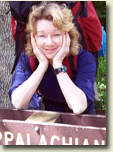 |
Priscilla
White Spitzer, 72N, 77MN, was named director of nursing
at Roane State Community College in 2003. The college has the largest
nursing program in Tennessee. She wrote the proposal to start the
program in 1979. Spitzer’s son, Noah, earned his BS at Emory
in 2001 in computer science. She and her husband, Ed, also have
a daughter, Casey. |
|
| |
|
|
|
| |
|
| |
 |
|
 |
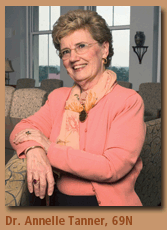
 r.
Annelle (Brown) Tanner, 69N,
once was afraid to turn off her son’s computer. A former
instructor in maternal and child health nursing, Tanner spent
25 years raising a family in Louisiana before she enrolled
in an educational technology course. The class was all about
computers. Today, she is an expert in nursing informatics,
the relatively new field that combines computer science, information
science, and professional training and knowledge to develop
and implement best-practice nursing. r.
Annelle (Brown) Tanner, 69N,
once was afraid to turn off her son’s computer. A former
instructor in maternal and child health nursing, Tanner spent
25 years raising a family in Louisiana before she enrolled
in an educational technology course. The class was all about
computers. Today, she is an expert in nursing informatics,
the relatively new field that combines computer science, information
science, and professional training and knowledge to develop
and implement best-practice nursing.
For their dissertations, Tanner
and Dr. Susan Pierce—an older nurse like herself—conducted
a pair of studies to assess the information literacy needs
of a random sample of nurses in Louisiana.
“Current research tells
us that most nurses do their jobs based on information they
learned in nursing school,” says Tanner, who spoke about
her work at the School of Nursing this summer. “For
many nurses, that information is decades old. Most nurses
in higher positions are over 40 or 50 and were educated before
computers became integral to health care. We began to understand
why information literacy is so important, especially since
health care information changes so rapidly. No one can keep
all of that information in their heads, so they have to know
how to access it quickly in an electronic environment.”
The research and searching required
to gather and aggregate information, and then apply it to
a particular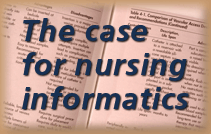 case, are special skills that can be taught, Tanner notes.
Instead of a thesis, some graduate nursing programs require
a systematic review of all research available to answer a
specific clinical question in a specific population so that
students can practice their research and application skills.
“This kind of training will benefit any nurse, especially
nurse practitioners who are managing clinics on their own,”
Tanner says.
case, are special skills that can be taught, Tanner notes.
Instead of a thesis, some graduate nursing programs require
a systematic review of all research available to answer a
specific clinical question in a specific population so that
students can practice their research and application skills.
“This kind of training will benefit any nurse, especially
nurse practitioners who are managing clinics on their own,”
Tanner says.
In recent years, Tanner and
her colleagues have conducted symposia on “Information
Resources for Evidence-Based Nursing” for nurses in
Louisiana (2001) and librarians at the Medical Library Association’s
annual meeting (2003). Attendees at both meetings provided
information resources for nurses. Follow-up results six months
later showed that journal reading increased by 30% (nurses)
and 32% (librarians), discussion increased by 37.5% and 27%,
incorporating research studies into their work increased by
27% and 29%, successful searching of electronic resources
for nursing information increased by 67% and 60%, and teaching
nurses to search increased by 44% (librarians).
In 2003–2004, Tanner’s
team conducted a mail survey using a national sample of all
U.S. nurses. The results “paint a dismal picture”
of how ill-prepared nurses are to practice nursing based on
evidence. Only slightly more than half of respondents were
familiar with the term “evidence-based practice,”
and even fewer bedside nurses (45%) were familiar with the
term. They cited “lack of value for research”
as the main barrier to the use of evidence in practice.
Tanner believes that will change.
The national study was just published in the September issue
of the American Journal of Nursing and will be used by nurse
educators, administrators, and clinicians to better prepare
nurses for current best practice based on evidence. Doctoral
students
in Iceland and Thailand also have requested permission to
use the survey instrument among nurses in both countries.
—Carol
Pinto

|
 |
|
|
| |
|
|
|
| |
|
1980s |
|
| |
|
|
|
| |
|
Born:
To Susanne Tunno Slocum, 87N, and her
husband, Robert Daniell, a son, Dean Daniell, on Nov., 23, 2004.
She serves as coordinator of cardiovascular screening and prevention
at St. Joseph’s Hospital in Atlanta. The family lives
in Alpharetta. |
|
| |
|
|
|
| |
|
1990s |
|
| |
|
|
|
| |
|
Born:
To Terri Wise Harper, 90N,
and her husband, Byron, another son, Josiah Byron Michael, on March
28, 2004. She is a stay-at-home mom, and her husband is an internist
in Fayetteville, GA. They have five children.
Kathleen (Kathy) Calitri Brown, 92MN, is now board
certified in the areas of wound, ostomy, and continence nursing.
A nurse for more than 30 years, Brown is manager of the Wound, Ostomy,
and Continence Program with the Visiting Nurse Service (VNS) of
Rochester and Monroe County, Inc. in New York. Brown has served
with the VNS since 2001.
Judith (Judy) Fitzpatrick, 93MN, is a nurse researcher
in pediatric endocrincology with the Department of the Navy. She
works at the Uniformed Services University of the Health Sciences
in Bethesda, MD, at Walter Reed Army Medical Center.
Born: To Judith Ramirez
Sherman, 91Ox, 93N, and her husband, Mark, a daughter, Alexa Grace,
on July 7, 2004. Sherman is a nurse practitioner at Gwinnett Anesthesia
Services in Lawrenceville, GA. The family, including big brother,
Garrett, lives in Buford.
Married: Stacey Allen,
94N, 99MSN, and Stephen Chapman on Feb. 26, 2005, in Atlanta. Allen
is a clinical adviser and nurse practitioner with Evercare, which
provides health plans for elderly, disabled, and chronically ill
people. The couple lives in Woodstock, GA.
Greg Smith, 96MN, has joined the Chattanooga Center for Pain Medicine
as a family nurse practitioner. Smith earned his BSN from the University
of San Francisco.
Married: Diane Morrison,
97N, 05MSN, and David Bray, 00C, 04MPH, on April 10, 2005, in a
small ceremony held in Cannon Chapel at Emory. Following the service,
the couple and a wedding guest planted a tree next to the chapel
and the Emory Quadrangle. Morrison plans to work as a pediatric
nurse practitioner in Atlanta. Her husband is associate director
of informatics for HIV/AIDS prevention at the CDC. |
|
| |
|
|
|
| |
|
| |
 |
|
| |
Preventing
patient
falls |
|
| |
 |
|
 |
 r.
Audrey Nelson, 80MN, is determined to reduce falls among the
elderly and infirm. As director of the Patient Safety Center
at the James A. Haley Veterans Hospital in Tampa, Florida,
Nelson oversees research to make patient r.
Audrey Nelson, 80MN, is determined to reduce falls among the
elderly and infirm. As director of the Patient Safety Center
at the James A. Haley Veterans Hospital in Tampa, Florida,
Nelson oversees research to make patient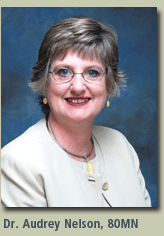 care safer at 171 VA hospitals and is currently leading a
$1 million study to prevent wheelchair falls.
care safer at 171 VA hospitals and is currently leading a
$1 million study to prevent wheelchair falls.
Three common activities account
for most falls among elderly and younger wheelchair users:
maneuvering over a curb, transferring in or out of vehicles,
and reaching down to pick up an item off the floor.
For the elderly population in
general, and veterans in particular, the center has developed
tools for predicting who will fall and who will be seriously
injured in a fall, along with interventions to prevent wheelchair
tips and falls.
“We’ve found that it’s not good to lump
together all people who are at risk for falls when implementing
fall prevention programs,” Nelson explains. “It’s
better to tease out the specific small groups (e.g., wheelchair
users, persons with Parkinson’s disease, or debilitated
elderly) to target specialized fall interventions. Then we
can more effectively fine-tune interventions that work for
that particular group.”
A number of risk factors also
affect an ambulatory person’s risk of falling, including
the patient’s gait and balance, their cognitive state,
and the number of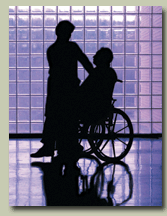 medications taken. Many older people have peripheral neuropathy
(reduced sensation in the extremities). “Their feet
are a little on the numb side, so they don’t pick up
their feet, which means they trip over things,” Nelson
says. “Of course, eyesight is a factor as well.”
medications taken. Many older people have peripheral neuropathy
(reduced sensation in the extremities). “Their feet
are a little on the numb side, so they don’t pick up
their feet, which means they trip over things,” Nelson
says. “Of course, eyesight is a factor as well.”
To help these patients, the
center is conducting a study comparing the effectiveness of
a balance-training course to practicing tai chi. After completing
their respective course, patients undergo a 3-D analysis of
their gait and balance to see how they have improved. Tai
chi is more effective for some, while traditional balance
training works better for others.
Additional studies have helped
identify risk factors for predicting falls among wheelchair
users. “We found that key risk factors in this patient
population include risky behaviors, alcohol use, and sometimes
muscle spasms,” says Nelson. “Also, the accessories
on wheelchairs make a big difference, such as the angle of
wheels, use of backpacks on the chair, and the use of anti-tipping
devices. We hope to contribute to improved designs of wheelchairs
for safety.”
Among other projects, Nelson
is helping launch a dynamic human motion analysis lab, which
will include an obstacle course to evaluate ambulation skills
for those in wheelchairs or wearing prostheses.
“They will be taught to
safely negotiate obstacles, improving their safety and mobility,”
Nelson says. “This will prepare them for life on the
outside, where they confront obstacles every day. Since we
have the course set up with 3-D data collection systems, we
have a sophisticated way to measure skill levels.”—Carol
Pinto |
 |
| |
 |
|
|
|
| |
|
|
|
| |
|
2000s |
|
| |
|
|
|
| |
|
Stephanie
Mickle deRijke, 01N, 04MSN, started what she calls her
dream job in July at the National Institute of Diabetes and Digestive
and Kidney Diseases (NIDDK) with the NIH. She is working with the
head of the NIDDK, focusing on patient care and research in gastroenterology.
Their research includes studies on irritable bowel syndrome and
granulomatous esophagitis. DeRijke will have opportunities to publish
and teach at schools like George Washington University.
“It took me over a year to get
this job, so if you have other students really interested in public
health, tell them not to give up!”she writes.
Joanne McDougal, 04MSN, is an information systems
clinical coordinator at Wellstar Health System in Atlanta. She is
enrolled in the Duke University Post Master Nursing Informatics
Program. She and her Duke classmates received the University of
Maryland Summer Institute in Nursing Informatics Peer-Review Paper
Presenter Award for 2005. Of the nearly 100 abstracts submitted,
their presentation was deemed of exceptionally high scholarly merit
and received the highest scholarship given by the committee. Only
two abstracts for paper presentations received this level of award
this year. |
|
| |
|
|
|
| |
|
FACULTY/STAFF
NEWS |
|
| |
|
|
|
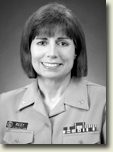 |
Patricia
Riley, a senior nurse midwife and international health
expert at the CDC, has been assigned to the School of Nursing for
several months to work on the next phase of the school’s Kenyan
nursing workforce project. Riley has served as a technical officer
on this project in partnership with nursing leaders in Kenya and
the Lillian Carter Center for International Nursing at Emory. The
project seeks to build information systems and a model to address
the nation’s nursing workforce issues. |
|
| |
|
|
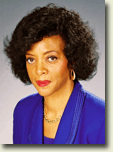 |
Dr.
Ora Strickland, professor in the Department of Family and
Community Nursing, was one of six nurses in Georgia to receive the
Profiles in Nursing Award from the Atlanta Black Nurses Association.
Strickland is an internationally known specialist in nursing research,
measurement, evaluation, and maternal and child health. |
|
| |
|
|
|
| |
|
IN
MEMORIAM
Alumni |
|
| |
|
|
|
| |
|
1930s |
|
| |
|
|
|
| |
|
Elma
A. Owens, 33N, on Dec. 3, 2002, at age 91. Survivors include
her daughter, Mary Jack.
Clara S. Donaszewski, 35N, of Hendersonville, NC,
on Oct. 19, 2004. She died the day before her 98th birthday.
Kathleen Rumble Brown, 37N, of Smarr, GA, on April
17, 2005, at age 89. As a first lieutenant with the U.S. Army, she
served with a training unit in Africa during World War II. Brown
was a plant nurse at the Bibb Company in Macon, GA, before she retired.
She is survived by a son, a brother, and a grandson.
Sarah Martin Harris, 39N, of Fernandina Beach, FL, on March
16, 2005, at age 90, following a long illness. After graduating
from Emory, she served for a short time as a private duty nurse
to Coca-Cola leader Robert Woodruff and his family. She later worked
as an office nurse/surgical assistant in Chicamauga, GA, and as
a hospital staff nurse in Chattanooga, TN, and Ft. Oglethorpe, GA.
Survivors include her only daughter, Sarah Cooper Pope of Fernandina
Beach, FL; two grandsons; and four great-grandchildren. Memorial
gifts may be sent to the Office of Development, Nell Hodgson Woodruff
School of Nursing, 1520 Clifton Road NE, Suite 446, Atlanta, GA
30322. |
|
| |
|
|
|
| |
|
1940s |
|
| |
|
|
|
| |
Edith Munroe Grupe, 42N, of Cedartown, GA, on March
22, 2004, shortly before her 83rd birthday.
Nancy D. Markell, 45N, of Missouri, on July 3,
2003, at age 79. Survivors include her daughter, Nancy.
Evelyn Brown Newsom, 46N, of Warrenton, GA, on
March 11, 2005, at age 80. She was the first public health nurse
in Warren County and retired from Gracewood Hospital. Survivors
include a son, a daughter, and four grandchildren.
Patricia Thompson, 46N, of Madision, FL, on June
30, 2005, at age 79. She was living in an assisted living nursing
home, where she lost her battle with cancer. Survivors include a
son, Julian Thompson, who accompanied her to class reunions. |
|
| |
|
|
|
| |
|
1950s |
|
| |
|
|
|
| |
|
Rose
Marie Moore, 53N, of Cleveland, GA, on July 7, 2005. Members
of the Class of 1953 have decided to make gifts to the Eliza-beth
Mabry Scholarship Fund at the School of Nursing in memory of Rose
Marie. Memorial gifts may be sent to the Office of Development,
Nell Hodgson Woodruff School of Nursing, 1520 Clifton Road NE, Suite
446, Atlanta, GA 30322. |
|
| |
|
|
|
| |
|
1970s |
|
| |
|
|
|
| |
|
Anne Reder-Bessent, 75MN, of Decatur, on April
20, 2005, at Hospice Atlanta. Born July 21, 1945, in New York City,
she was raised in New Jersey and received her nursing degree from
Seton Hall University. She worked at Georgetown Hospital in Washington,
D.C. Prior to earning her master’s degree in public health
nursing at Emory, she served as a liaison nurse with the Maternal
and Infant Care Project and the Regional Perinatal Center at Grady
Memorial Hospital and taught at Brenau University. She earned a
second master’s degree in psychiatric nursing at Georgia State
University. After two years in private practice as a therapist,
Reder-Bessent returned to the Grady Psychiatric Emergency Clinic.
She served at Florida Hall, the outpatient psychiatric unit at Grady,
until March 2005. She is survived by her husband, Eugene C. Bessent,
72C, and a daughter. |
|
| |
|
|
|
| |
|
1990s
|
|
| |
|
Daniel
Alan Hunt, 95N, of Atlanta, on March 17, 2005, at age 35.
Survivors include his father, Billy M. Hunt. |
|
| |
|
|
|
| |
|
|
|
| |
|
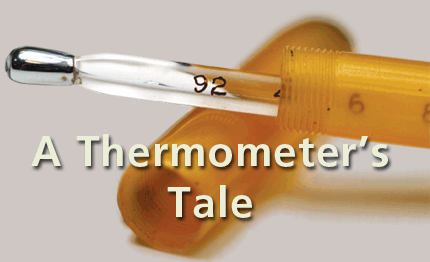 |
| |
 |
|
 |
Evelyn
Coker Briscoe, 28N, was a nurse from the old school.
She graduated from the Wesley Memorial Hospital Training School
for Nurses, predecessor to the current nursing school. Her
son, Nowell Briscoe, and daughter, Diane Briscoe Wright, have
several keepsakes from their mother, who died in June 1979
at age 72. In addition to her nursing pin with the letters
WMH, a 1928 Emory yearbook, and her graduation invitation,
they have a thermometer and case, which looks like a fountain
pen.
“In those days, the hospitals
would provide their nurses with their own thermometers,”
says Nowell. “Mother held onto it, which was the only
thermometer I can ever remember her using for our family.”
One of his mother’s best
friends in nursing school was Mildred Elliott (later Hardy),
who served as head nurse at Agnes Scott College for many years.
For some reason, Nowell has her diploma instead of his mother’s.
“Maybe they swapped diplomas because they were best
friends. They’re both dead now, so I guess we’ll
never know.”
“After mother graduated,
she nursed at Emory and did some part-time nursing at Grady.
It was while nursing at Emory that she met my father,”
Nowell continues. “He would accompany his parents to
Emory when they had health problems. Anyway, they met and
some time later decided to elope. Mother told me she wore
her wedding ring on a chain around her neck so no one would
know she was married. When word finally got out, both sets
of parents were outraged and demanded a public service, which
they had, in June 1929.”
|
 |
 |
|
 |
 |
The
young couple moved to Monroe, GA, and raised their children
there. Briscoe did private duty nursing for family and friends.
“When any of her friends were sick or coming back from
the hospital, it was my mother they all called on to help
in the recovery,” Nowell says.
The family had a good friend in Dr.
Philip R. Stewart, who graduated from Emory School of Medicine
the same year Briscoe graduated from nursing school. He became
their family doctor. “Whenever I needed injections before
school started, he let mother give me my shots as she could
give a shot with no pain at all.” (Lucky for Nowell!)
Once the polio vaccine was available,
Briscoe joined with other nurses in town to give the oral
medicine to the community. A photo from the local paper shows
her (left in photo) in the 1960s, during one of her last stints
giving the vaccine. She did private duty nursing for many
years until her own health declined and she had to give up
nursing.
Briscoe was the first of three
generations to attend Emory. Daughter Diane attended Emory
in the late 1950s, and a nephew graduated in 1986. Currently,
Nowell serves as gift coordinator for University Libraries.
He jokes that bringing her nursing pin and thermometer to
campus to have them photographed for Emory Nursing is the
first time she’s been back since the 1950s. But her
memory lingers on. —Carol Pinto |
 |
| |
 |
|
|
|
| |
|
|
|
| |
|
FACULTY/STAFF |
|
| |
|
|
|
| |
|
Addie
Pardue (“Tad”) Rountree of Decatur, GA, on
June 14, 2005, at age 92. Tad served the School of Nursing as secretary
for the master’s program from about 1970 until she retired
in 1984.“Tad ran the graduate program when I came here in
1978,” recalls Dr. Lynda Nauright, professor of nursing. “She
was the secretary to the graduate program director, but it was clear
who was really in charge.”
Others remember Rountree just as clearly.
“Tad was one of the greats,” adds Dr. Sally Lehr, clinical
assistant professor. “She always knew where I was supposed
to be and what my course numbers were. One day I walked in with
a purple dress on, and she said to me, `I don’t believe I
much like you in purple, do you?’ That was classic Tad.”
Originally from North Carolina, Rountree
attended Lenoir Rhyne College. In Atlanta, she was a charter member
of Clairmont Hills Baptist Church. Survivors include two daughters,
Elizabeth and Mary Ann; their husbands; five grandchildren; and
four great-grandchildren.
At Rountree’s request, memorial
contributions may be sent to Clairmont Hills Baptist Church, 1995
Clairmont Road, Decatur, GA 30033, or to the Office of Development,
Nell Hodgson Woodruff School of Nursing, 1520 Clifton Road NE, Suite
446, Atlanta, GA 30322. |
|
| |
|
|
|
| |
|
|
|
|
|
|
